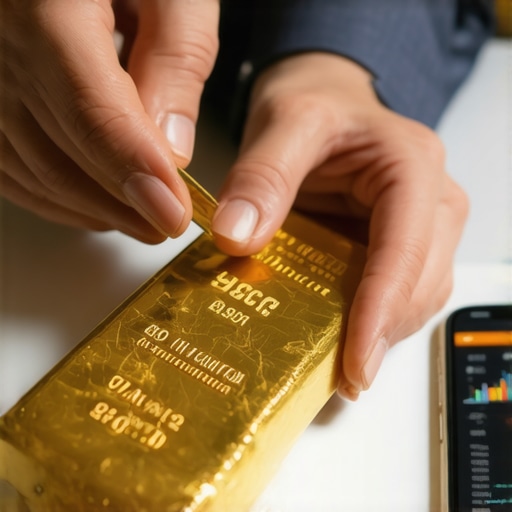Understanding the Basics of Gold Investment
Investing in gold has become increasingly popular among beginners looking to diversify their portfolios and protect themselves from economic uncertainties. As a tangible asset, gold has been a valuable store of wealth for centuries, making it a go-to option for many investors. In this step-by-step guide, we will explore the essential aspects of investing in gold, including the different types of gold investments, strategies for beginners, and crucial tips to maximize your returns.
Types of Gold Investments: Which is Right for You?
There are several ways to invest in gold, each with its own set of advantages and considerations. Understanding these options can help you make informed decisions tailored to your investment goals.
- Physical Gold: This includes gold bars, coins, and jewelry. Investing in physical gold allows you to own a tangible asset, which can be stored at home or in a secure facility. However, it often requires higher upfront costs and ongoing storage and insurance considerations. Check out our guide on physical gold vs. gold coins for more insights.
- Gold ETFs: Exchange-traded funds (ETFs) are investment funds that track the price of gold and are traded on stock exchanges. They offer a more accessible way to invest in gold without the need to store physical assets. For a deeper understanding, see our resource on the best gold ETFs.
- Gold Mutual Funds: These funds invest in gold mining companies or hold gold bullion. They provide diversification within the gold sector and are managed by professionals. If you want to learn more about investing in gold mutual funds, read our article on gold mutual funds for 2025.
- Gold Mining Stocks: Investing in stocks of companies that mine gold can offer significant returns, especially if gold prices rise. However, it comes with additional risks related to the company’s performance. Explore our insights on maximizing gains through gold mining stocks.
Strategies for Beginners: How to Start Investing in Gold
For those new to the gold market, having a clear strategy is vital. Here are some tips to guide you:
- Start Small: As a beginner, it’s wise to start with a small investment. This allows you to learn about the market without taking on excessive risk.
- Diversify Your Portfolio: Gold should be one part of a diversified investment strategy. Consider combining it with other assets like stocks and bonds to manage risk effectively.
- Stay Informed: Keep up with gold market trends and news. Understanding market dynamics will help you make better investment decisions. For instance, check out our gold market analysis for the latest insights.
By following these strategies, beginners can navigate the complexities of gold investment with greater confidence. The next step involves understanding the market factors that influence gold prices and how to make timely investment decisions.
Key Factors Influencing Gold Prices: What Beginners Need to Know
Understanding the dynamics of gold prices is crucial for any new investor. Numerous factors can influence the value of gold, and being aware of these can help you make informed decisions about when to buy or sell. Here, we explore the primary drivers of gold prices, including economic indicators, geopolitical events, and market sentiments.
The Role of Economic Indicators in Gold Pricing
Economic indicators are essential in forecasting gold prices. Key metrics such as inflation rates, interest rates, and currency strength can significantly impact the gold market. For instance, when inflation rises, gold often becomes a preferred asset as it tends to retain its value better than fiat currencies. Additionally, lower interest rates can lead to higher gold prices, as investors seek alternatives to yield-bearing assets.
To understand how these economic indicators affect your investments, consider exploring our understanding gold price forecasts article. This resource delves into how various economic trends can shape the gold market.
Geopolitical Events: Their Impact on Gold Prices
Geopolitical tensions, such as conflicts, trade wars, or political instability, can cause fluctuations in gold prices. During times of uncertainty, investors often flock to gold as a safe haven, driving its value up. For example, recent geopolitical tensions have led to increased demand for gold, emphasizing its role as a hedge against risk. If you’re interested in how these events can impact your investments, check out our analysis on the impact of geopolitics on gold prices.
Market Sentiment and Its Influence on Gold Prices
Market sentiment plays a significant role in determining gold prices. Positive or negative news can sway investor confidence, leading to rapid changes in demand. For beginners, it’s essential to stay updated with market trends and sentiments. Regularly checking resources like the gold market analysis can provide valuable insights into current market conditions.
Understanding Supply and Demand Dynamics
The classic economic principle of supply and demand is central to gold pricing. When demand for gold exceeds supply, prices tend to rise. Conversely, when supply outpaces demand, prices may drop. Factors affecting supply include mining output and central bank purchases. If you want to explore these trends further, our article on gold supply and demand insights offers a comprehensive overview.
As you navigate your investment journey, understanding these fundamental factors will empower you to make strategic decisions regarding your gold investments. Next, we will look at practical strategies for investing in gold, including how to evaluate different investment avenues and ensure your portfolio is well-diversified.
Practical Strategies for Investing in Gold: Maximizing Your Returns
When investing in gold, having a structured approach can significantly enhance your potential returns. Whether you opt for physical gold or gold-related securities, the strategies you implement will determine your success in the gold market. Here, we delve into effective strategies for gold investment that can help you maximize your returns.
Evaluating Gold Investment Avenues: Making Informed Choices
Before committing your funds, it’s crucial to evaluate the different avenues available for gold investment. Each option has its unique characteristics, risks, and rewards. For instance, when considering gold ETFs, look at their management fees, liquidity, and historical performance. Understanding these factors can help you choose the best investment that aligns with your risk tolerance and financial goals.
Understanding Gold Market Trends: Staying Ahead of the Curve
Being aware of the latest trends in the gold market is essential for any investor. Historical price movements, seasonal fluctuations, and macroeconomic indicators can influence gold prices. Regularly checking resources such as our gold market analysis can provide you with insights into current trends and future predictions, allowing you to make informed investment decisions.
Utilizing Technical Analysis: A Key Tool for Investors
Technical analysis involves studying price charts and market patterns to predict future price movements. By mastering this technique, you can make more accurate buying and selling decisions. Investors can use various indicators, such as moving averages and relative strength index (RSI), to gauge market momentum. If you’re looking to enhance your trading skills, consider exploring our guide on analyzing trends in the gold market.
Timing Your Investments: The Importance of Entry and Exit Points
Knowing when to enter or exit a gold investment is crucial for maximizing returns. Market timing can significantly impact your investment performance. For example, buying during market dips or selling during high demand periods can yield substantial profits. To understand better when to buy or sell, familiarize yourself with market cycles and price trends. Our article on gold price predictions can provide valuable insights into the best times to make your investment moves.
Risk Management: Protecting Your Gold Investments
Effective risk management is essential for safeguarding your investments. Diversifying your gold holdings can mitigate risks associated with market volatility. By spreading your investments across different gold assets, such as gold stocks, ETFs, and physical gold, you can reduce the potential impact of price fluctuations. Additionally, regularly reviewing your investment portfolio can help you adjust your strategies based on market conditions. For further tips on risk management, check out our resource on buying gold coins for investment success.
Continuous Learning: Staying Informed and Adapting
The gold market is constantly evolving, and staying informed is vital for ongoing success. Attend investment seminars, read financial news, and engage with expert analyses to adapt your strategies effectively. This continuous learning approach will ensure you’re equipped to navigate changing market conditions and capitalize on new opportunities. For beginners, our guide for beginners offers a solid foundation to start your journey.
As you implement these strategies, remember that patience and discipline are key to successful gold investing. The next step involves exploring specific investment products and understanding how to evaluate their performance in the current market landscape.
Investment Products: Navigating the Gold Investment Landscape
As you delve deeper into the world of gold investing, it’s crucial to understand the various investment products available. Each option presents unique benefits and risks, making it essential to evaluate them carefully. In this section, we will explore different gold investment products, highlighting their features and how they can fit into your overall investment strategy.
Gold Bullion: A Tangible Asset for Serious Investors
Gold bullion, in the form of bars or coins, serves as a direct investment in physical gold. Owning bullion means you possess a tangible asset that can be stored securely. However, this form of investment requires careful consideration of storage costs and insurance. For those considering this option, our guide on buying gold bullion can provide essential tips to ensure a successful purchase.
Gold ETFs: A Convenient Alternative
Exchange-traded funds (ETFs) offer an efficient way to invest in gold without the hassle of storing physical assets. Gold ETFs track the price of gold and can be bought and sold like stocks on major exchanges. This option is ideal for investors looking for liquidity and ease of access. To maximize your ETF investments, check out our article on maximizing returns with gold ETFs.
Gold Mining Stocks: Potential for High Returns
Investing in gold mining stocks involves purchasing shares of companies that extract gold. This investment form can yield significant returns, especially when gold prices are on the rise. However, it also carries risks associated with the company’s operational performance. If you’re interested in exploring this avenue, our post on maximizing gains through gold mining stocks offers valuable insights.
Gold Mutual Funds: Diversification Made Easy
Gold mutual funds pool investors’ money to invest in a diversified portfolio of gold-related assets, such as mining stocks and bullion. This option allows for broad exposure to the gold market, reducing the risk associated with individual investments. If you’re keen on mutual fund investments, our comprehensive guide on investing in gold mutual funds can provide you with the necessary details.
Evaluating Performance: Metrics to Consider
When assessing various gold investment products, it’s essential to have metrics in place to evaluate their performance. Here are some key indicators:
Understanding Historical Performance
Reviewing the historical performance of gold investments can provide insights into their potential for future returns. Look for patterns in price movements over different economic conditions. Our article on forecasting gold prices gives a comprehensive overview of how historical trends can guide your investment decisions.
Expense Ratios and Fees
For ETFs and mutual funds, pay close attention to expense ratios and management fees, as these can significantly impact your overall returns. Lower fees typically mean higher net returns for investors. To understand more about evaluating these costs, refer to our insights on best practices for physical gold investments.
By carefully evaluating these investment products and performance metrics, you can make informed decisions that align with your financial goals. Remember, the key to successful investing in gold lies in understanding your options and staying updated on market trends.
Frequently Asked Questions (FAQs) About Gold Investment
1. What are the benefits of investing in gold?
Investing in gold provides several benefits, including diversification of your portfolio, protection against inflation, and a hedge against economic uncertainty. Gold’s intrinsic value and historical performance make it a reliable asset during market volatility.
2. How do I start investing in gold as a beginner?
To start investing in gold, begin by educating yourself on different types of gold investments, such as physical gold, ETFs, and mining stocks. Consider starting with a small investment, and gradually diversify your holdings while staying informed about market trends.
3. What is the best way to store physical gold?
Physical gold can be stored in a safe at home, a bank safety deposit box, or in a secure storage facility. Each option has its pros and cons, including cost, accessibility, and security. Choose a method that aligns with your investment goals and comfort level.
4. How often should I review my gold investments?
It is recommended to review your gold investments at least annually, or more frequently if market conditions change significantly. Regularly assessing your portfolio allows you to adapt your strategies based on performance and market trends.
5. What factors should I consider before investing in gold mining stocks?
When investing in gold mining stocks, consider the company’s financial health, mining efficiency, management team, and geopolitical risk associated with its operations. It’s also essential to analyze the stock’s historical performance and its correlation with gold prices.
6. Are gold ETFs a good investment option?
Gold ETFs can be an excellent option for investors looking for liquidity and ease of access without the need for physical storage. They offer diversification within the gold market and can be traded like stocks, making them a convenient investment vehicle.
7. Can gold investments lose value?
Yes, like any investment, gold can lose value. Prices can fluctuate based on market demand, global economic conditions, and other factors. However, gold is often viewed as a stable asset during economic downturns, making it a less risky option compared to other investments.
8. How does geopolitical tension affect gold prices?
Geopolitical tensions tend to increase demand for gold as investors seek safe-haven assets. During periods of political instability or conflict, gold prices often rise due to heightened uncertainty and risk in the markets.
9. What are the tax implications of investing in gold?
The tax implications of investing in gold vary by country. In many places, gold is classified as a collectible, which may incur higher capital gains taxes upon selling. It’s essential to consult with a tax professional to understand the specific regulations applicable to your situation.
10. How can I stay updated on the gold market?
To stay updated on the gold market, regularly follow financial news outlets, subscribe to newsletters from reputable financial advisors, and engage with investment communities. Resources like Kitco and World Gold Council provide valuable insights and analyses.
Authority Resources for Gold Investment
For those looking to deepen their understanding of gold investment, here are some trusted resources:
- Kitco News – A leading platform for precious metals market news, analysis, and price quotes.
- World Gold Council – The global authority on gold, offering research, insights, and data on gold investment trends.
- Investopedia – Gold Investment Guide – Comprehensive articles on various aspects of gold investment.
- BullionVault – A platform that allows you to buy and store physical gold securely.
- Morningstar – A trusted source for investment research, including gold ETFs and mutual funds.
These resources will help you stay informed and make educated decisions about your gold investments.
Conclusion: Navigating Your Gold Investment Journey
Investing in gold can be a rewarding venture when approached with knowledge and strategy. By understanding the different investment avenues, evaluating products, and staying informed about market trends, you can maximize your returns and safeguard your portfolio. Embrace the journey of gold investment, and remember that knowledge is your greatest asset. As you explore this market, stay committed to continuous learning and adapt your strategies to align with your financial goals.










As someone who’s been exploring various gold investment options, I found the section on different types of gold investments particularly helpful. I’ve actually started with a small physical gold purchase, mainly coins, because I wanted something tangible. The advice on storage and insurance considerations was a good reminder for me to review my current storage plans. I’ve been curious about ETFs since they seem more flexible, but I wonder, how do they generally perform compared to physical gold over the long term? Also, I like the emphasis on staying informed and continuously learning—it’s so true that markets can change quickly, and keeping up with economic indicators and geopolitical events can really influence investment decisions. For beginners especially, do you have suggestions on which resources are most accessible for staying updated regularly without feeling overwhelmed? Would love to hear others’ experiences or recommendations on balancing different gold investment types in a diversified portfolio.